DirectFB Project Draws Up Plans For The Future

When announcing the Weston DirectFB support, Denis Oliver Kropp also shared PDF slides concerning the plans and future of DirectFB. In now having time to go through the "DirectFB Foreseeing" content, here's some of the other interesting items that the project has planned or is working on presently:
- A new IPC (Inter-Process Communication) framework that's simpler, offers better performance, provides better security, and can handle network transparency.
- Support for multiple outputs on different systems with support for different client APIs for surface buffers / windows.
- A generic DirectFB-based implementation of OpenWF as well as a DirectFB plug-in to support OpenWF vendor implementations. The Open Windowing Foundation (OpenWF) is a cross-platform Khronos Group API for low-level hardware abstraction of composited windowing systems. OpenWF is mainly used for mobile/handheld systems. A while ago there was OpenWF activity for Wayland but that support was dropped.
- As covered already, a DirectFB-based Wayland Weston implementation. DirectFB developers feel it can provide better frame-timing for accurate animations, support more than one buffer in the queue, and can then integrate with other DirectFB clients. Wayland clients could also optionally use DirectFB straightaway to create buffers and benefit from 2D acceleration.
- DirectFB WebKit support with handling for WebGL as well as OpenGL acceleration via Cairo GLES2/DRM or SkiaGL.
- LXC Linux Containers support for running master and slaves in different containers and extended separation of shared memory buffers.
- A Qt5 QtCompositor port (potentially using Wayland) and further Qt5 optimizations on DirectFB.
- Support for mapping DirectFB virtual screens onto different physical displays of the same or multiple source. Among the different physical displays supported by DirectFB right now include DRM/KMS, VNC, X11, Qt/GTK, and remote DirectFB displays.
- 3D input device support is desired like the Leap Motion hardware.
- Multi-touch support is still to be done within the DirectFB world.
- Remote DirectFB devices are also sought after like a handheld device for remote control or obtaining input from another box.
- Improved compositing and a system-wide compositor for seem-less transitions from boot, views of applications in different layouts, and handling of compositing by one or more processes.
- Code clean-ups.
6 Comments

